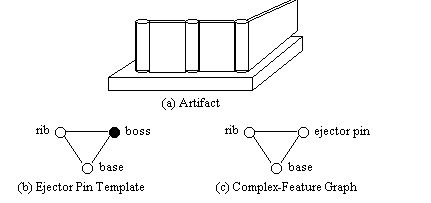6.2 FEATURE SPECIFICATION
6.2.3 COMPLEX-FEATURE TOPOLOGY MATCHING
Recognition of complex-features can involve graph pattern matching and would use essentially the same technology used upon FEV graphs for simple-feature recognition. However, explicit designation of variations of topology are not as much of concern in the feature graphs as the FEV graphs. Whereas a variety of FEV configurations could define a single simple-feature, a variation within a simple-feature configuration would define a different complex feature. Also, definitions of simple features from FEV graphs must be of elements and procedures greatly unfamiliar to experts in design and manufacturing, while definitions of complex features use elements recognizable by these experts.
Identification of a complex feature from a matching template is done in one of two manners: composition or isolation. A complex feature can be constructed by compounding the nodes or it can be isolated as a subgraph. Figure 64 illustrated compounded feature identification with the two bosses composing a mounting post and two ribs composing a snap tab. Figure 65 illustrates isolation which involves matching several nodes but labeling only a subset of those nodes as the identified complex feature. The artifact of (a) produces a feature-graph not shown. The template of (b) is matched against the feature graph. For a given match, the boss node is identified as an ejector pin as in (c).
Figure 65 Ejector Pin Forms and Templates
